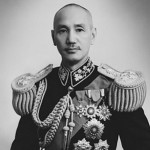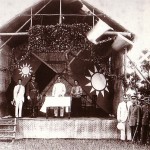
Jiang Jieshi (Wade-Giles: Chiang Kai-shek) was the powerful nationalist military commander who succeeded Sun Yixian (Sun Yat-sen) as leader of the Guomindang. In the mid-1920s Jiang led a successful expedition to conquer powerful northern warlords and became the ruler of a reunified China. Jiang remained the nominal president of China for the next 20 years. During the 1930s many considered him the natural leader of a newly created but inherently unstable Chinese republic. Whether in a dapper Western suit or the full-dress uniform of a generalissimo, Jiang seemed to represent a modern China, rather than the old world of the Qing. He also combined Sun Yixian’s hopeful nationalism with Yuan Shikai’s decisive militarism; Jiang was committed to a united Chinese republic but unlike Sun he had the military muscle to achieve it. Yet despite Jiang’s prowess and strong-man persona, his two decades as president of China were dogged by internal opposition and external threats. Hostile warlords, Guomindang rivals, Japanese imperialists and communist revolutionaries all challenged Jiang’s rule. It eventually collapsed in 1949 when much of China was overrun by communists. Jiang himself fled to Taiwan, where he established an alternative Chinese government and ruled until his death in 1975.
Jiang Jieshi was born in 1887 in Zhejiang province on China’s east coast. Jiang’s father was a prosperous merchant who traded mainly in salt and wine, his mother a restrained and obedient wife. At age 19 Jiang, inspired by China’s slow but determined push for ‘self-strengthening’, enrolled at Yuan Shikai’s New Army military academy at Baoding. The following year he left to study at Rikugun Shikan Gakko, Japan’s premier officer training academy; after graduating in 1909 he volunteered for two years in the Japanese military. While stationed in Tokyo Jiang’s friends introduced him to Sun Yixian and other nationalists; Jiang, already a supporter of Chinese republicanism, was inspired to join Sun’s Tongmenghui. He returned to China in 1911 and participated as a military leader in the Xinhai Revolution, commanding artillery units against Qing forces in Hangzhou. Jiang was also involved in the Guomindang’s unsuccessful July 1913 revolution against Yuan Shikai, before fleeing to Japan. He later returned secretly to China, living in the foreign sections of Shanghai and working with the Green Gang, a notorious gangster clique. These connections with the Shanghai underworld would later prove useful during Jiang’s purge of communists in the spring of 1927.

After Yuan Shikai’s death in mid-1916, Sun Yixian and many of his followers, including Jiang, returned to southern China. Jiang’s planning and command of nationalist regiments were instrumental in the founding of a military republic in Guangdong province. By the early 1920s, he had become both a member of Sun Yixian’s government and the republic’s military commander. In early 1924 Jiang was sent to Moscow, where he spent four months studying Soviet military training and organisation. On his return to Guangzhou Jiang was appointed commandant of the newly formed Huangpu (Wade-Giles: Whampoa) Military Academy, a facility for training Guomindang officers. Huangpu was modelled on Soviet academies that combined military training with political indoctrination. Jiang was generally supportive of the Guomindang-communist alliance, however, his personal politics were anti-communist and he was wary of Soviet intrusions into the management of Huangpu. In late 1924 Jiang threatened to resign as commandant after a dispute with Soviet advisors. The Soviets themselves advised Moscow that Jiang was “hostile” to communism and would have to be “managed”.

Sun Yixian died in 1925, leaving several powerful lieutenants but no succession plan. Two of the main contenders, Wang Jingwei and Hu Hanmin, occupied the left-wing and right-wing of the party respectively. As a military commander, Jiang Jieshi had avoided most of the Guomindang’s factional wrangling and internal power struggles; little was known of his personal politics. In the end, it was his military successes that allowed Jiang to challenge for the Guomindang leadership. In 1925 Jiang was put in charge of the first nationalist army assembled from Huangpu graduates; the following year he was appointed as commander-in-chief of the 100,000-strong National Revolutionary Army (NRA). In July 1926 Jiang commanded the first of two expeditions, marching the NRA north to engage the powerful Zhili warlords. The Zhili militias were formidable but proved no match for the NRA, which was led by trained officers and equipped with Russian and German weapons. After this success, Jiang focused his attention on perceived threats within his own party. In April 1927 he instigated a purge of communists in Shanghai; weeks later forces loyal to Jiang attacked Wuhan, where Wang Jingwei had positioned himself at the head of a new national government. These were the first of many campaigns Jiang Jieshi would launch against communists, who he despised as puppets of Moscow rather than true Chinese nationalists.
“Mao [Zedong] was famous for his lack of grooming and his peasant ways; Jiang, as one visitor remarked, had ‘the air of fastidious distinction’. The Great Helmsman wore baggy blue peasant clothes and a Red Army cap; the Generalissimo neat suits, silk robes, uniforms hung with medals and a velvet Western trilby. Jiang was slim, erect, precise, his lips thin, his head shaven… Except when he flew into one of his fits of temper, Jiang exuded self-control; whatever his inner calculations, Mao behaved expansively to visitors, appearing to take them into confidence, even if this was to seduce them into his ideological embrace.”
Jonathon Fenby, historian
In 1928 Jiang and his forces completed a second expedition to suppress the Fengtian clique in Manchuria and northern China. By the middle of the year, Jiang’s forces had either defeated or absorbed most of the warlord armies in northern and eastern China. With the isolation of his main rival Wang Jingwei, Jiang was now the undisputed leader of the Guomindang. In October 1928 Jiang was placed in charge of the State Council, making him the de facto leader of the Chinese republic. Under Jiang’s rule, a nationalist government was formed in a new capital, Nanjing, closer to the Guomindang’s natural support base. Jiang declared that China was entering the second of Sun Yixian’s three stages of development: a period of ‘political tutelage’, where leaders would educate the people in the ways of democracy, though without giving them any control of the government. Outside the government Jiang courted the support of China’s powerful business interests and affluent landlords; these elites drew closer to Jiang after his suppression of communists in April 1927. Jiang also exploited the legacy of the late Sun Yixian by intensifying the cult of personality that had emerged after Sun’s death, ordering that Sun’s body be entombed in a grand mausoleum. Jiang also developed and refined his own political rhetoric, so that it mirrored that of Sun’s. In December 1927 Jiang married his third wife, Soong May-ling, the younger sister of Sun’s widow; later dubbed ‘Madame Jiang’ by the Western press, she became a significant political figure in her own right.

1. Jiang Jieshi was a Guomindang military commander who came to lead the party after the death of Sun Yixian.
2. He sided with Sun while receiving military training in Japan, then commanded troops in the 1911 Revolution.
3. In 1924 he became commandant of Huangpu military academy and commander of the National Revolutionary Army.
4. Jiang’s successes in suppressing northern warlords fuelled his rise to prominence in the late 1920s.
5. In April 1927 Jiang revealed his anti-communist position by ordering the mass arrest and execution of communists in Shanghai. The following year he became the leader of the national government, closely aligning himself with the political legacy of Sun Yixian.
© Alpha History 2018-23. Content on this page may not be republished or distributed without permission. For more information please refer to our Terms of Use.
This page was written by Glenn Kucha and Jennifer Llewellyn. To reference this page, use the following citation:
G. Kucha & J. Llewellyn, “Jiang Jieshi“, Alpha History, accessed [today’s date], https://alphahistory.com/chineserevolution/jiang-jieshi/.
This website uses pinyin romanisations of Chinese words and names. Please refer to this page for more information.
